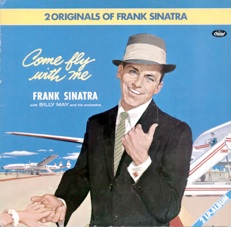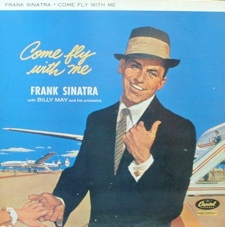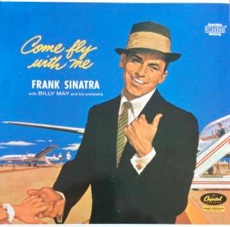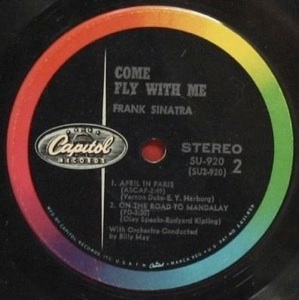









But wait! There’s more!
SH.TV member stevelucille was kind enough to send along clips of the stereo EP set -- actually referred to by Capitol as “Little LPs” -- manufactured exclusively for use in jukeboxes.
But wait! There’s more!
Now you know my opinion. Please share yours and join the conversation about COME FLY WITH ME at the Steve Hoffman Music Forum.

But wait! There’s more!
If you like this album, please be sure to check out this one, also with new songs by Cahn-Van Heusen, and arrangements by Billy May:
Click on the photo below to hear a brief clip.
Clearly, this format was not aimed at the home-audio market, as it has almost no bass and sounds thin overall, at least to my ears. Still, a neat novelty to have in one’s Sinatra collection. Thanks for sharing with us, Steve!


Back in 2009, when this page was initially posted, my concluding comments began thusly: <<To my ears, two releases stand out over all the others I’ve heard: The 1983 MFSL LP, and the excellent stereo CD remix by Larry Walsh,>> and I still think there’s a case to be made for that being true. However, new versions have since been released and existing-but-then-unobtained editions have now come to light to muddy the waters a bit. Here is my 2015 effort to make sense of all this stuff:
Mono versions: While I remain un-enthralled by the mono recording overall, we have had three excellent re-masterings of that recording in the last few years: 2009 and 2014 LPs (both well-mastered by Ron McMaster at Capitol in Hollywood) and the 2014 HD download. The McMaster LPs strike me as being superior to any previous mono LP editions, and the HD is a close second only to the McMaster LPs, and is a worthwhile purchase.
Stereo versions: In 2009, I commented that the original stereo LPs did not impress me, and I still feel that way. In blind listening, these LPs, along with the 1970s Scully-cut SM- and SY- LPs, are completely bland and bring nothing special to the table. Now having a handful of additional masterings with which I’ve become familiar, I think I’ve come to see the following as being accurate: All stereo releases of this album prior to 1976 basically stink. The original mastering was poor, and no effort was really made to approach the album’s sound in a new, more-inviting way until the German 2-LP set, 2 Originals of Frank Sinatra, was released in 1976. Starting with that release, we begin to see a degree of “revisionist thinking” for the sound of this LP in stereo -- and based on the original mastering’s sound, this is a title that NEEDED revisionist thinking!
To my ears, these (below) are the stereo LP versions that are worth seeking out, and none is like the other. They all have a unique sound. (Audio clips on page two.)

1976 German 2-fer LP
Warmth and punchiness in spades, verging on being tubby at times. Maybe a hair too revised, but a very pleasantly-aggressive listen, notwithstanding, and with none of the aural anemia that blemishes the earlier stereo LP releases. The approach of this mastering, though perhaps not executed to perfection, was many years overdue.
1983 MFSL Boxed Set LP
Beautifully warmed up, wildly revised tonality. (I keep envisioning mastering engineer Jack Hunt pulling his hair out, working and re-working this one, trying to find that elusive “sweet spot.”) When it works, it works beautifully, and I greatly enjoy this version, but in places the added warmth is a bit too pillowy. (When does an overstuffed chair reach the point of being TOO stuffed?) Regardless, I have a real soft spot for this edition, the equivalent of sitting in a very soft, comfy chair. (Technical note: Side two, track one has a mild hum.)

1984 UK “Dell” LP
VOCAL CLARITY -- Want to put on headphones and feel like Frank is singing into your ears? This is the one to get. The vocal just cuts through and sparkles. The band is very clear sounding as well. That said, this version is certainly lacking in the warmth department, making it a little overly-lean, but the crystal clarity makes for a very enticing listen. (Technical note: There is some odd digital skipping on the source tape used for side two, track one.)

This DMM pressing is, tonally, squarely between the MFSL and UK releases. If you don’t want a version that leans too bright or too dark, this is an excellent middle-of-the-road choice. Very nicely done, but it’s kind of the well-behaved, studious, quiet kid in the classroom, the one that doesn’t draw a lot of attention to himself, but performs at a consistently high level. This is arguably the best of the four items described here, but it will do nothing to make you go “WOW, that’s different” like the other three will. It’s a solid performer, though. NOTE: Oddly, this album was released in 1984 in both mono and stereo versions using the SAME CATALOGUE NUMBER for both, #1A 038-2600951. Both were sold in a STEREO sleeve. When purchasing, carefully verify which version you are getting! See more info starting here.)
1984 Netherlands “Dell” LP
(Discogs link - see note below)
Full disclosure: There is one LP edition that is conspicuous in its absence, and that’s a 1970s/1980s Capitol USA pressing cut on the Neumann lathe. The Scully cuts I’ve heard are all duds, but I’d love to hear a Neumann cut (they do exist), and if I get an LP or a clip, I will post the audio here.
In terms of CD releases, there is really only one that is top-grade in my opinion, and that’s the 1987 CD that was remixed by Larry Walsh. To my knowledge, this CD marked the first attempt to rectify the technical gremlins that infect five of the songs on the stereo version, and Mr. Walsh did a bang-up job. It’s not 100% perfect (some songs are panned in a bit; the first note of “Isle of Capri” is cut off; some of the tweaks done to overcome the defects are mildly distracting), but it’s darned good and highly recommended, as good a place to start with this album as any, and that’s a high compliment. When push comes to shove, this CD is probably also my “top choice” for this album, although I’m very fond of the four LPs mentioned above, and prefer the original stereo mix when the technical problems are not in play.


